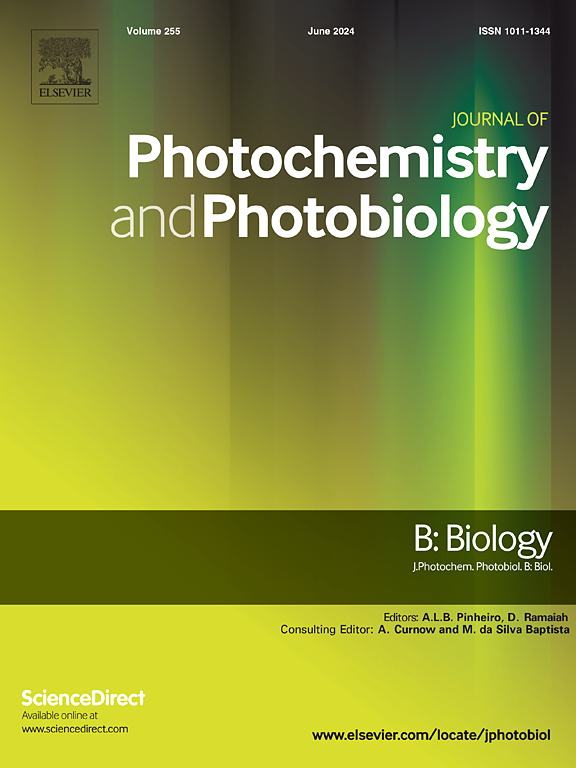Effect of various carbon supports for TiO2 and N-doped TiO2 photocatalysts for inactivation of Escherichia coli in water under UV–visible light
IF 3.7
2区 生物学
Q2 BIOCHEMISTRY & MOLECULAR BIOLOGY
Journal of photochemistry and photobiology. B, Biology
Pub Date : 2025-05-07
DOI:10.1016/j.jphotobiol.2025.113180
引用次数: 0
Abstract
This study evaluates the effectiveness of various carbon nanostructures carbon glassy spheres (CGS), carbon nanopowder (CNP), and activated carbon (AC) as supports for TiO2 and N-TiO2 photocatalysts in the inactivation of Escherichia coli (E. coli) in water. The photocatalysts were synthesized using a sol-gel method. Transmission electron microscopy (TEM) and X-ray diffraction (XRD) analyses confirmed the presence of anatase-phase TiO2 on the carbon supports, with the synthesized TiO2 nanoparticles exhibiting particle sizes below 10 nm. Fourier transform infrared (FTIR) spectroscopy identified metal‑oxygen bonds and surface hydroxyl groups on the photocatalyst surface, while X-ray photoelectron spectroscopy (XPS) confirmed the Ti4+ oxidation state and nitrogen incorporation in nitrogen-doped TiO2 (N-TiO2) samples. The photocatalytic performance of these materials was investigated for E. coli inactivation under both UV and UV–visible light irradiation. Results demonstrated that carbon-supported TiO2 and N-TiO2 nanocomposites exhibited significantly enhanced photocatalytic activity compared to their unsupported counterparts. Superior photocatalytic performance was observed under UV–visible light compared to UV light. Among the three carbon-supported systems, TiO2 and N-TiO2 nanocomposites deposited on CGS achieved the highest photocatalytic activity. The enhanced performance was attributed to the morphology and particle size of the carbon supports, which played critical roles in optimizing photocatalytic inactivation of E. coli in water.

不同碳载体对TiO2和n掺杂TiO2光催化剂对水中大肠杆菌灭活的影响
本研究评估了不同碳纳米结构碳玻璃球(CGS)、碳纳米粉(CNP)和活性炭(AC)作为TiO2和N-TiO2光催化剂在水中对大肠杆菌(E. coli)失活的效果。采用溶胶-凝胶法制备光催化剂。透射电镜(TEM)和x射线衍射(XRD)分析证实了碳载体上存在锐钛矿相TiO2,合成的TiO2纳米颗粒粒径小于10 nm。傅里叶变换红外光谱(FTIR)鉴定了光催化剂表面的金属氧键和表面羟基,而x射线光电子能谱(XPS)证实了氮掺杂TiO2 (N-TiO2)样品中的Ti4+氧化态和氮掺杂。研究了这些材料在紫外光和紫外光可见光下对大肠杆菌灭活的光催化性能。结果表明,碳负载的TiO2和N-TiO2纳米复合材料的光催化活性显著增强。与紫外光相比,在紫外-可见光下观察到更好的光催化性能。在三种碳负载体系中,沉积在CGS上的TiO2和N-TiO2纳米复合材料具有最高的光催化活性。碳载体的形貌和粒径对优化水中大肠杆菌的光催化失活起着至关重要的作用。
本文章由计算机程序翻译,如有差异,请以英文原文为准。
求助全文
约1分钟内获得全文
求助全文
来源期刊
CiteScore
12.10
自引率
1.90%
发文量
161
审稿时长
37 days
期刊介绍:
The Journal of Photochemistry and Photobiology B: Biology provides a forum for the publication of papers relating to the various aspects of photobiology, as well as a means for communication in this multidisciplinary field.
The scope includes:
- Bioluminescence
- Chronobiology
- DNA repair
- Environmental photobiology
- Nanotechnology in photobiology
- Photocarcinogenesis
- Photochemistry of biomolecules
- Photodynamic therapy
- Photomedicine
- Photomorphogenesis
- Photomovement
- Photoreception
- Photosensitization
- Photosynthesis
- Phototechnology
- Spectroscopy of biological systems
- UV and visible radiation effects and vision.

 求助内容:
求助内容: 应助结果提醒方式:
应助结果提醒方式:


